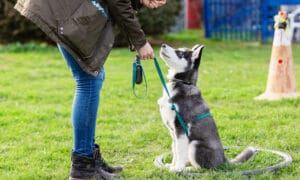“This post contains affiliate links, and I will be compensated if you make a purchase after clicking on my links.”

“I have been training my dog all week and she is just not getting it. Emily only listens when she wants, this is frustrating and seems pointless. Help!” – Mark K.
I get it, we live in an instant gratification society. We have instant coffee, drive through ATMs, microwaves, instant communication, etc. This has put us in the habit of wanting things fast and easy. Modern technology has increased at a rapid pace, but our dog’s canine genetics have not. When it comes to training dogs, you cannot fairly and efficiently rush the training process.
Most people who start training their dog wants and expects to have their dog listen regardless of distractions and without treats. We all envision our dog listening like Rin Tin Tin and acting like Lassie in order to save Timmy from the well. However 99.9% of dogs never come even close to a reliable “Come” or “Stay” with mild levels of distractions. Why is that? It’s not because dogs are stubborn or lack intelligence, it’s because owners rush the training process.
Slow and steady wins the race, avoid “crash and burn dog training” at all costs. Most people start a diet on January 1st by throwing away all junk food and trying to run 3 miles their first day at the gym. This sets them up to fail and never continue. This is a crash and burn diet/fitness routine. The same thing happens with dog training. People go all out and expect their dog to listen with high-levels of distractions in the first week, then they get frustrated because they don’t and quit.
So how do you avoid “crash and burn dog training” and stay the course to success? You must ensure your dog achieves continued success, while testing and overcoming failure. One way to gauge this is through Pareto’s 80/20 Principle.
If your dog achieves “it” (whatever you a trying to work on) at least 80% of the time, increase the difficulty. If your dog gets “it” less than 80% of the time, decrease the difficulty. What does this look like in practical terms?
Dog is in a Sit-Stay 10 feet away from me. He successfully holds that position 9 out of 10 times, I am able to increase the difficulty.
Whereas, if the dog breaks the Sit-Stay 5 out of 5 times, it’s too much – I am rushing the process. As a result, I need to decrease the difficulty in order to achieve the 80/20 ratio of success.
In order to create true reliability and success, you must proof your dog on the Three D’s of Dog Training: Distance, Duration and Distractions. If you lack in any one of these areas, you will experience significant reoccurring lack of compliance.
Pareto’s Principle of 80/20 is not the only way to gauge progress, it’s just one method to provide an objective view for owners. Having a clear and systematic way to improve, will set you and your up for success, by avoiding the common pitfall of crash and burn dog training.
Dog trainer Steve Reid, of S.R. Dog Training provides in-home dog training in Westchester NY and Putnam NY. Read more about S.R. Dog Training at www.srdogtraining.com and “Like” on Facebook: www.Facebook.com/SRDogTraining.



















Pingback: Ask the Trainer: Avoid ‘Crash & Burn’ Training to Set Your Dog Up for Success – Todayz Top Stories